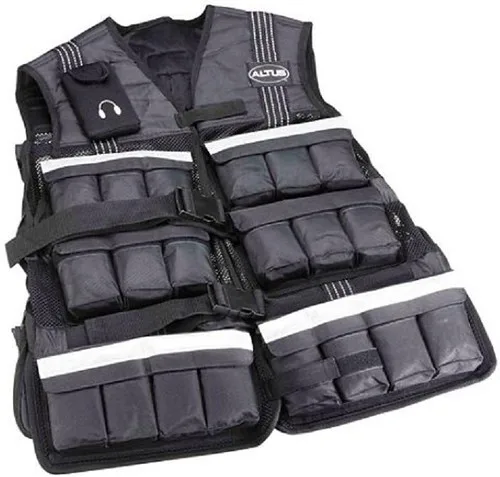Definition of Weighted Vest
- A weighted vest is a snug, sleeveless garment worn over the torso that has small weighted inserts sewn into compartments around the vest.
Explanation
- Weighted vests add extra resistance to bodyweight exercises and other activities like walking, running, and hiking. The added weight increases muscle activation, strength, and endurance.
- Weighted vests typically weigh between 5-60 lbs. The weight is adjustable by adding or removing the weighted inserts from the pockets as needed.
- Proper fit is important to allow full range of motion and prevent injury. The weight should be evenly distributed and properly secured.
Examples
- Using a 20 lb weighted vest during push-ups or pull-ups
- Jogging with a 10 lb weighted vest on
Related Terms of Weighted Vest
- Progressive overload – Weighted vests allow you to gradually increase resistance over time by adding small amounts of weight as you adapt. This progressive overload continues building strength.
- Resistance training – Weighted vests add resistance to bodyweight exercises, transforming them into resistance training that builds muscle and strength.
- Strength training – Doing exercises like squats and lunges with a weighted vest is an effective form of strength training to improve lower body power.
- Functional training – Weighted vests can be used for functional training by adding resistance to everyday movements like walking, running, and stair climbing. This builds full-body functional strength.
Weighted vests are a versatile resistance training tool that allows progressive overload, strength building, and functional training by adding weight to bodyweight exercises in a graded manner. They enhance many popular training programs.
Common Questions about Weighted Vest
- How much weight should I start with in a weighted vest? Start with 10-20% of your bodyweight. For a 150 lb person, that’s 15-30 lbs. Slowly increase weight over time.
- What exercises can I do with a weighted vest? Walking, running, squats, lunges, push-ups, pull-ups, planks, and most full body exercises.
- How tight should a weighted vest fit? It should fit snugly and securely to minimize movement during exercise, but not restrict breathing or movement. Straps should keep it centered on your torso without shifting.
The key is to start with a lighter weight vest and progressively increase the weight over time as your body adapts. Ensure it fits snugly, but allows full range of motion. Weighted vests provide a convenient way to add resistance to bodyweight training.
Do Not Confuse With
- Weightlifting belt – A weightlifting belt is worn around the waist to help support the core and lower back during exercises like heavy squats, deadlifts, and overhead presses. It helps maintain torso stability and intra-abdominal pressure. It does not add resistance like a weighted vest.
- Ankle/wrist weights – Light ankle or wrist weights (1-3 lbs) are intended to add resistance during flexibility exercises, not to build strength. Heavy ankle and wrist weights can overstress joints. A weighted vest properly distributes weight across the torso for safer resistance training.
In summary, a weightlifting belt supports the spine during heavy lifts, while ankle/wrist weights are for flexibility. A weighted vest specifically allows progressively adding resistance to exercises to build functional strength in a safer, more distributed manner. It serves a different purpose than those other accessories.
Thank you for reading this post, don't forget to subscribe to our free newsletter
!
